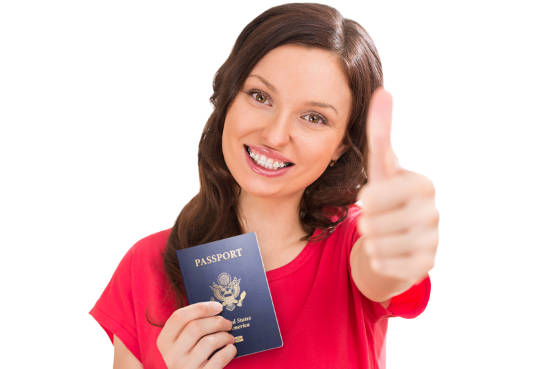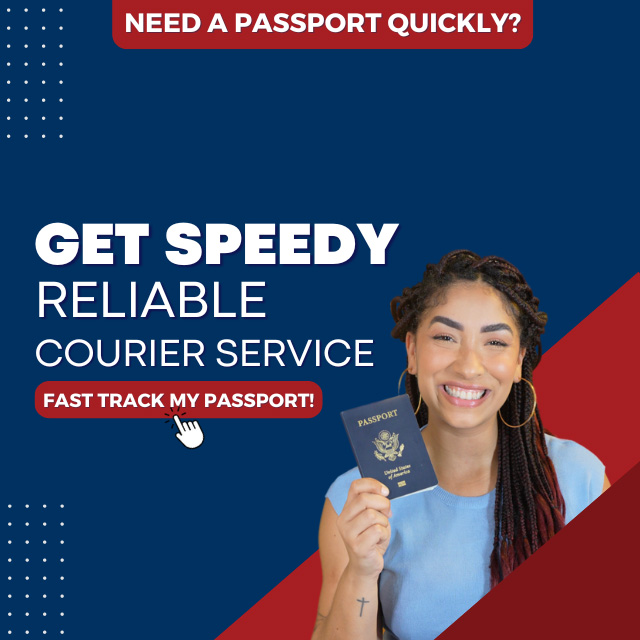
Happy passport bearer by hasloo/DepositPhotos
There are few things more exciting than when your first passport
arrives in the mail. After all, it's your ticket to the world. All
kinds of new possibilities open up to you once you get a passport, but
with great privilege comes great responsibility. When your first passport arrives, there are some steps you can take right away to get it travel-ready and to keep it secure.
After your initial euphoria, the first thing you will want to do with your new passport is verify your information on the personal data page.
You can find this on page 2 of your passport; it's the page with your
photo, name, country, date of birth, place of birth, and gender. It
also has your passport number and its issuance and expiration dates.
Carefully inspect these information for errors. If you find printing or
spelling errors, or incorrect data on your passport, you can request a passport correction with Form DS-5504,
your present passport, and evidence of correct data.
The passport will
be valid for ten years from the date that the corrected passport is
issued to you.
If you wait beyond a year, however, you can still
receive a free, corrected passport, but the expiration date will remain
the same as your original passport.
The next thing you will want to do to protect your passport is to sign it
on page 3. You should do this with a pen in black ink, and your
signature should match the name printed on page two of your passport.
If, for whatever reason, you sign incorrectly (maybe you accidentally
sign your spouse's instead of your own, or sign your maiden name
instead of your married name), don't panic. Just draw a straight line
through it and sign it again above where you previously signed.
Page 5
of your U.S. passport states that it is not valid if it is not signed
on page 3.
On page 4 you will find a space for your address in the U.S.,
and a space for the address of where you will be staying outside the
U.S. On the bottom of the page, you will find space for an emergency
contact in the U.S. Fill in the name, address, and U.S. telephone
number of a person to contact at home in the event that you have an
emergency on your travels. Remember that your passport is valid for 10
years, and things change. Write all information on this page in pencil, so it can be changed as needed.
Once you have completely reviewed your passport, validated it with your
signature, and filled out your emergency information, it is time to make copies.
Scan your passport into your computer and send a copy to your own
e-mail account; save another one in Dropbox, or a similar cloud storage
system.
This way, if your physical passport is lost or stolen, you will
have proof of identity and can expedite the process of receiving a
replacement passport at a U.S. Consulate.
Besides saving virtual copies of your passport to your computer and
cloud storage for easy retrieval from any location, you will also want
to print out two copies.
Leave one at home with a trusted friend or
relative who will not be accompanying you on your travels. Bring the
other one with you.
Once you arrive at your destination, put your
original passport in a secure location, like a room safe, for example,
and carry the copy of your passport with you whenever you leave the
hotel. This minimizes the risk of your passport being lost or stolen
while you are out sightseeing.
Now that your passport is all ready to go, the best thing to do is get a RFID-blocking passport case or travel wallet.
Not only will it help protect your passport from being bent, torn, or
otherwise damaged, it will also help keep your personal data safe.
RFID-blocking covers keep your digital passport from being unlawfully
tracked, skimmed, or cloned. Buying RFID-blocking products also keeps
credit cards safe. Keep these documents together with visas,
immunization records, insurance cards, international driver's licenses,
and any other important travel documents.
So you've gathered together all your important documents, including your passport into a travel wallet, now what? Store them in a secure location such as the bestselling SentrySafe H2300 Fire-Safe Waterproof Chest .
It is not a good idea to store them in a public storage unit, both for
the obvious risk, and also the limited hours of operation. Storing them
in a safety deposit box in a bank also offers limited access and is not
recommended.
Your passport is now travel-ready and secure; the only thing left is to grab your hat and sunglasses, and book that international dream vacation!
.
It is not a good idea to store them in a public storage unit, both for
the obvious risk, and also the limited hours of operation. Storing them
in a safety deposit box in a bank also offers limited access and is not
recommended.
Your passport is now travel-ready and secure; the only thing left is to grab your hat and sunglasses, and book that international dream vacation!
Top 5 Questions About Expedited Passport Couriers
1. How can you get a passport when you're in a hurry?
2. What exactly does a passport expediter do?
3. Are passport expediting services legitimate?
4. How can I identify a reliable passport expeditor?
5. Is expedited passport service worth it? Get answers to these questions and more in our Ultimate U.S. Traveler's Guide to Passport Expediters.
2. What exactly does a passport expediter do?
3. Are passport expediting services legitimate?
4. How can I identify a reliable passport expeditor?
5. Is expedited passport service worth it? Get answers to these questions and more in our Ultimate U.S. Traveler's Guide to Passport Expediters.
You can also visit our library of articles about passport expediting.
In a Hurry? Get Reliable Expedited Passport Courier Service:Expedite My U.S.Passport Now!


